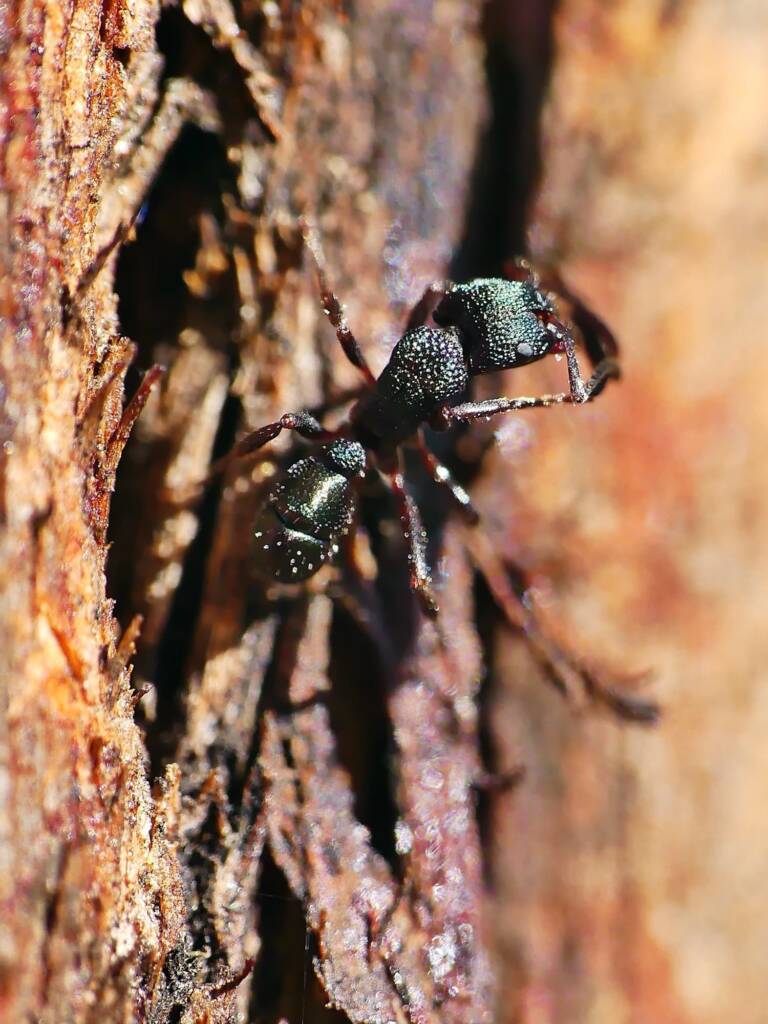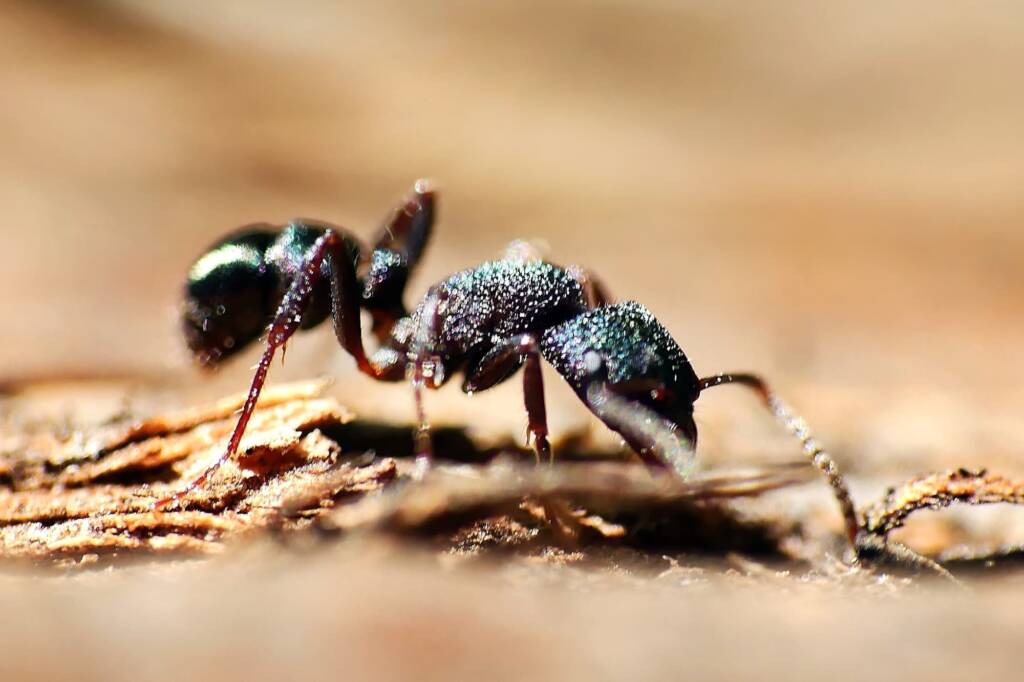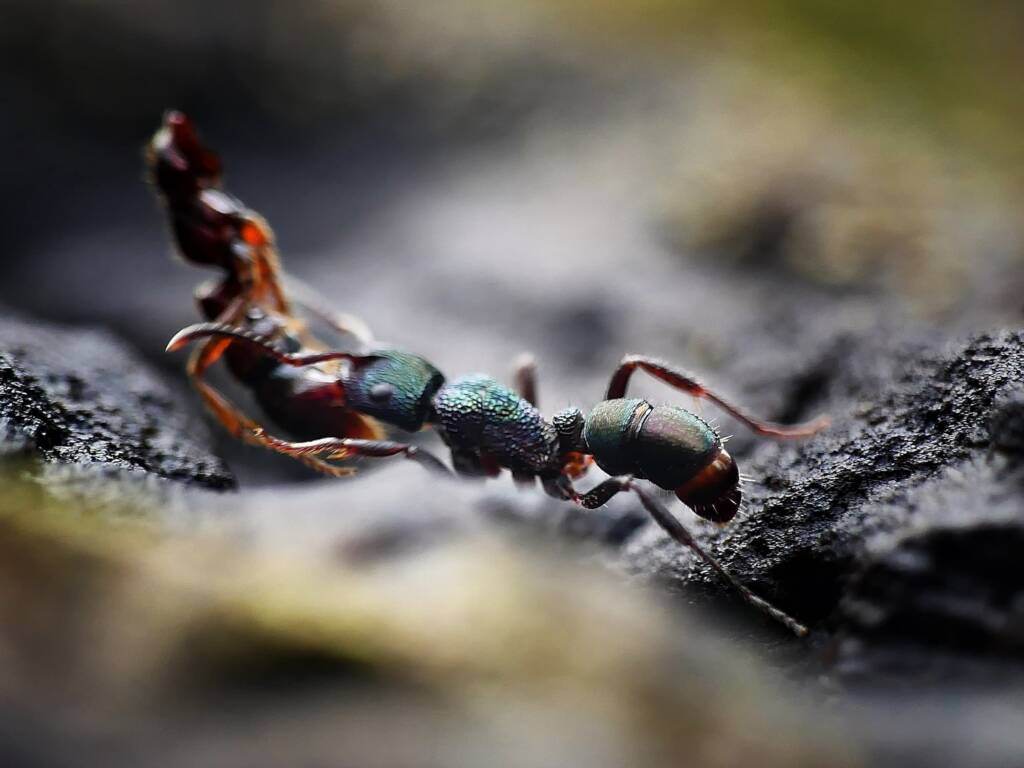FormicidaeAnts Camponotus aurocinctus Camponotus consobrinus (Banded Sugar Ant) Camponotus inflatus (Honey Ant) Dolichoderus doriae (Dolly Ant) Leptomyrmex erythrocephalus (Red-headed Spider Ant) Myrmecia brevinoda (Nocturnal Bull Ant) Myrmecia nigrocincta (Jumping Jack Ant) Myrmecia pilosula (Jack Jumper Ant) Myrmecia pyriformis (Inch Ant) Myrmecia rubripes (Bullant) Notoncus spinisquamis Oecophylla smaragdina (Green Tree Ant) Rhytidoponera aspera Rhytidoponera metallica (Green-head Ant)
Rhytidoponera metallica is a species of ant endemic to Australia, commonly known as the Green-head Ant. Sometimes shortened to “green ant”, confusion can arise, as the “green ant” in northern Queensland, is the common name for another green-tree ant (Oecophylla smaragdina).
They have a distinctive metallic appearance, that can vary from green to purple or even reddish-violet. They are about 6 mm in length and their legs and mandible brownish in colour. Among the most widespread of all insects in Australia, green-head ants are found in almost every Australian state, except Tasmania.

Rhytidoponera metallica are diurnal (active throughout the day) and found living in a variety of habitats, including forests, woodland, deserts and urban areas. They can be found nesting underground below logs, stones, twigs, and shrubs, in decayed wooden stumps, and on occasion found living in termite mounds.

They prey on arthropods and small insects and collect sweet substances such as honeydew from sap-sucking insects. They prey on agricultural pests such as beetles, moths and termites. They play an important role in seed dispersal, scattering and consuming seeds from a variety of species. Their predators include the short-beaked echidna (Tachyglossus aculeatus) and a variety of bird species.


- Scientific classification
- Kingdom: Animalia
- Phylum: Arthropoda
- Subphylum: Hexapoda
- Class: Insecta
- Informal: Pterygotes
- Order: Hymenoptera
- Superfamily: Verspoidea
- Family: Formicidae
- Subfamily: Ectatomminae
- Genus: Rhytidoponera
- Species: Rhytidoponera metallica
Footnote & References
- Green-head Ant (Rhytidoponera metallica), Photographs © Marianne Broug
- Green-head Ant, mariannebroug, iNaturalistAU, https://inaturalist.ala.org.au/observations?place_id=any&subview=map&taxon_id=201975&user_id=mariannebroug&verifiable=any
- Green-head Ant, Wikipedia, https://en.wikipedia.org/wiki/Green-head_ant
- Rhytidoponera metallica (Smith, 1858), Atlas of Living Australia, https://bie.ala.org.au/species/https://biodiversity.org.au/afd/taxa/81aa2878-5c8c-45b1-9517-834a03e477ea
FormicidaeAnts Camponotus aurocinctus Camponotus consobrinus (Banded Sugar Ant) Camponotus inflatus (Honey Ant) Dolichoderus doriae (Dolly Ant) Leptomyrmex erythrocephalus (Red-headed Spider Ant) Myrmecia brevinoda (Nocturnal Bull Ant) Myrmecia nigrocincta (Jumping Jack Ant) Myrmecia pilosula (Jack Jumper Ant) Myrmecia pyriformis (Inch Ant) Myrmecia rubripes (Bullant) Notoncus spinisquamis Oecophylla smaragdina (Green Tree Ant) Rhytidoponera aspera Rhytidoponera metallica (Green-head Ant)
InsectsBees Beetles Blattodea Butterflies Coleoptera Cicada Crabronidae Diptera Dragonflies & Damselflies Formicidae Hemiptera Heteroptera (True Bugs) Mango Planthopper Moths Orthoptera Orthopteroid Processionary Caterpillar Stink Bugs, Shield Bugs and Allies Syrphidae Wasps Water Scorpion (Laccotrephes tristis) Witchetty Grub
